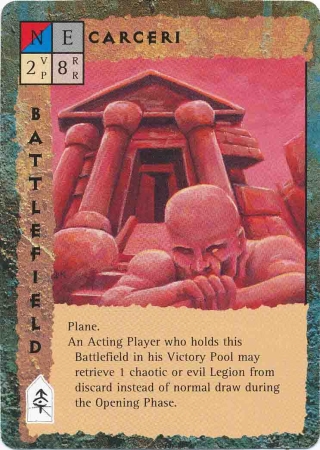
Tarterus

| 1. Othrys | 2. Cathrys | 3. Minethys | 4. Colothys | 5. Porphatys |
| - | - | 6. Agathys | - | - |
| The Outer Planes | - | Deities & Demigods | - | Manual of the Planes |
The sixfold layers of
Tarterus are a fell region inhabited by
monsters
&& great evil beasts. It is the home of many evil powers
in exile, such as the greater titans,
who were driven out of Olympus,
and creatures planning their revenge against
others.
The worlds of Tarterus
are laid out like strings of huge crimson
pearls, each pearl the size of a Prime
Material world. The surfaces
of these world-sized pearls vary according
to the layer, yet all
give off a dull reddish glow from their
soil, similar to the phosphoresence
of fire beetles. This bathes all the layers
of Tarterus in a
hellish light, but they are no hotter
than a summer's afternoon on
the Prime Material. The space between
these worlds is filled with
air, so that travellers can fly from world
to world in relative safety.
Unlike the globes of the PMP, the worlds
of Tarterus do not spin.
They receive their heat from the ground
and
light from both the ground and the adjacent
orbs. There is no day
or night in Tarterus, save at the wishes
of the Powers of particular
realms. Seasons and weather SWEEP this
primeval plane in a random fashion,
so that heavy storms can follow clear
sky. The
scare plant life bursts into full flower
after a storm and then withers
in hours.
The size of the orbs
of Tarterus and their distance from one
another along varies from layer to layer,
as does the terrain.
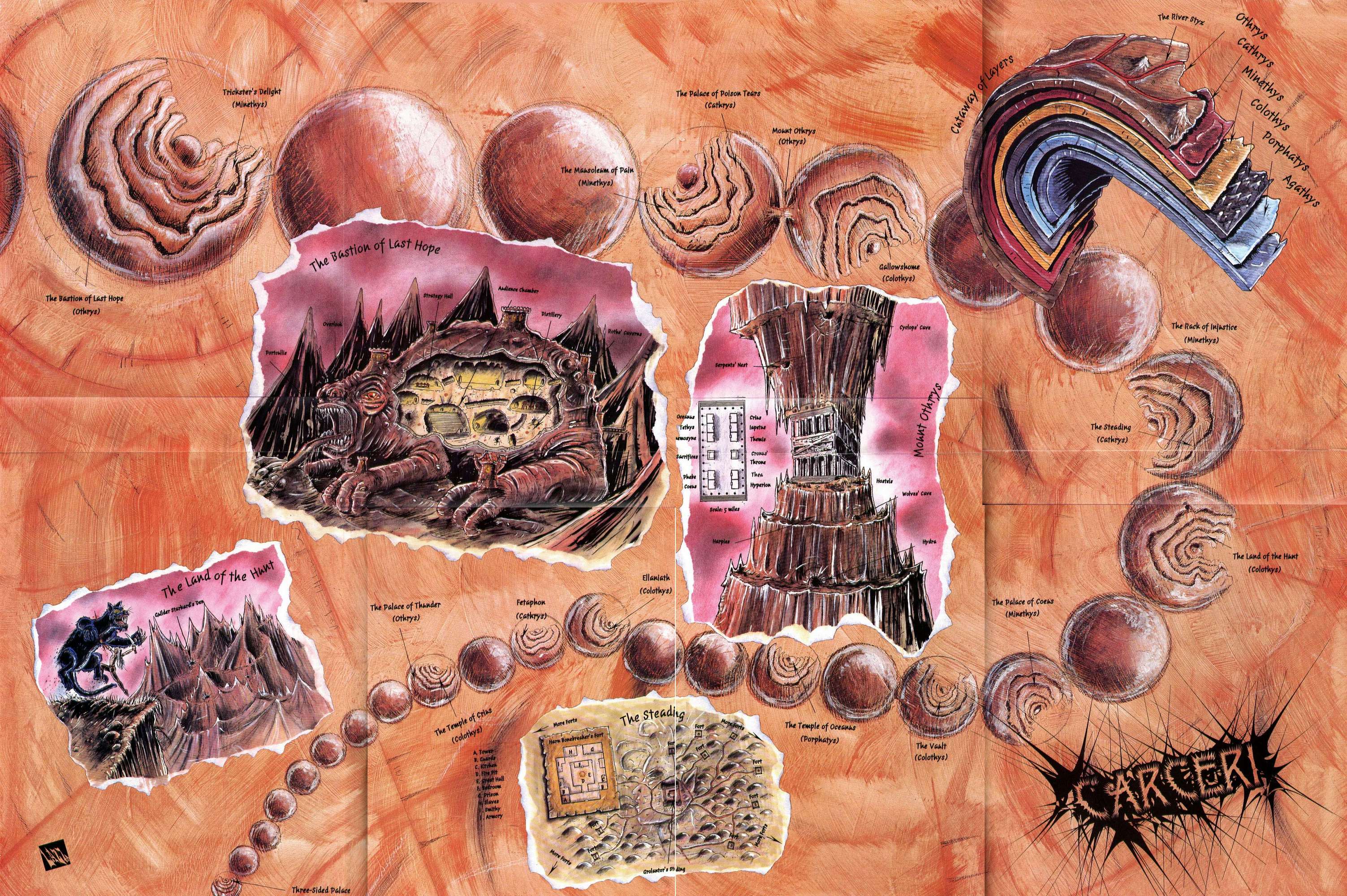
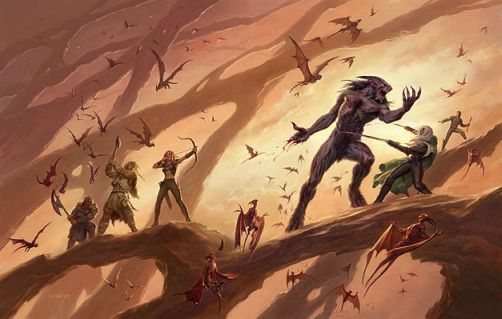
Othrys is the topmost layer of the
plane. It is the home of the
greater titans, who are far superior to
those that roam the PMP.
THe great orbs here are only about 100
miles
from each other--a distance that can easily
be crossed. This layer
is named for its chief inhabitants, who
live where two
mountains from adjacent worlds touch (see
Features of Tarterus, page
104). The upper layer is marshy for the
most part; most worlds
have soft ground that often breaks into
bogs and areas of glowing
quicksand. The Styx and innumerable other
rivers flow through
this layer on all the worlds. They provide
an easy method of travel
from world to world without passing through
the gulf between the
orbs. What solid ground there is (outside
of mountains such as
Othrys itself) is soft, like peat, and
broken by deep chasms.
Cathrys is the second layer of Tarterus.
Its worlds are smaller
than that of Othrys, so that there is
a 500-mile gap between
adjacent orbs. Cathrys is a layer filled
with worlds of overblown
jungles and scarlet grasslands. The plant
life of Cathrys is harmful,
however, and secretes a powerful acid
that eats through
metal in 1d10 rounds and delivers 1d6
points of damage to those
in contact (natives are, of course, immune).

Minethys, the third layer of Tarterus,
has orbs smaller than
those of Cathrys, so that there is 5,000
miles between orbs. Hard
winds blow through the airy gulfs that
separate the worlds of
Minethys. Minethys is desert-like, as
the windstorms that begin in
the airy gulf SWEEP huge clouds of foul-smelling,
poisonous,
stinging dust across the land (effectively
a perma cloudkill spell).
Every 10 days, a massive tornado sweeps
the planescape, <alt>
carrying any in its path to an adjacent
orb or an orb on another
string entirely.
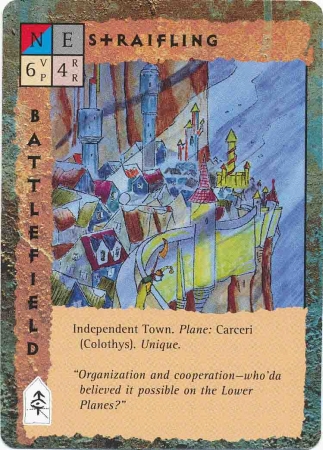
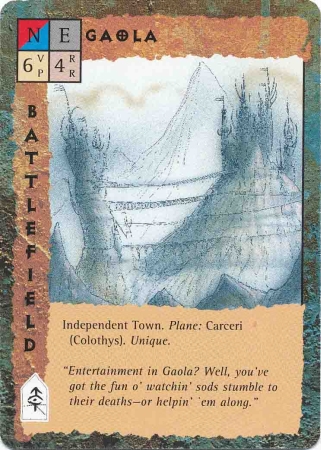
Colothys is the
fourth and most mountainous layer of Tarterus.
Its orbs are a half-million miles apart
(about twice the distance
between the Earth and its moon). The orb-like
realms here are
more oddly-shaped and spiked, as the mountains
thrust hundreds
of miles from base to topmost spur. The
region is broken by
all manner of deep hell-chasms; canyon
walls are home to
legions of demons && daemons.
Porphatys is
the fifth layer of Tarterus. It is the wettest and
second coldest layer (Agathys is the coldest).
The orbs are
millions of miles apart in this layer.
In the gulf between the worlds
MOVE great black
clouds laden with demonic snow. This snow
is acidic in nature--those with xposed
skin caught in a snowstorm
suffer 1d4 points of damage per round.
The acidic nature
of the black snow
rots cloth in 10 rounds, but it has no effect on
stone || metal. The orbs are continually
subjected to the black snow, <link:
Black Snow, by Tryptikon>
which sticks only on the topmost peaks
&& melts elsewhere.
Thus the surfaces of the orbs are covered
in 1d6 feet of water.
Fallen water && snow on the ground
retain their acidic
properties, though natives of Tarterus
are immune to their
effects.
Agathys is the
deepest of the known layers of Tarterus and the
coldest. Other orbs are totally lost to
VIEW here; the realm the individual
occupies floats alone in a
pitch-black sky. The orbs are
covered with dark
ice streaked in red. The atmosphere
is
similar to that on the peaks of mountains
on the PMP
(deathly cold and hard to breathe).
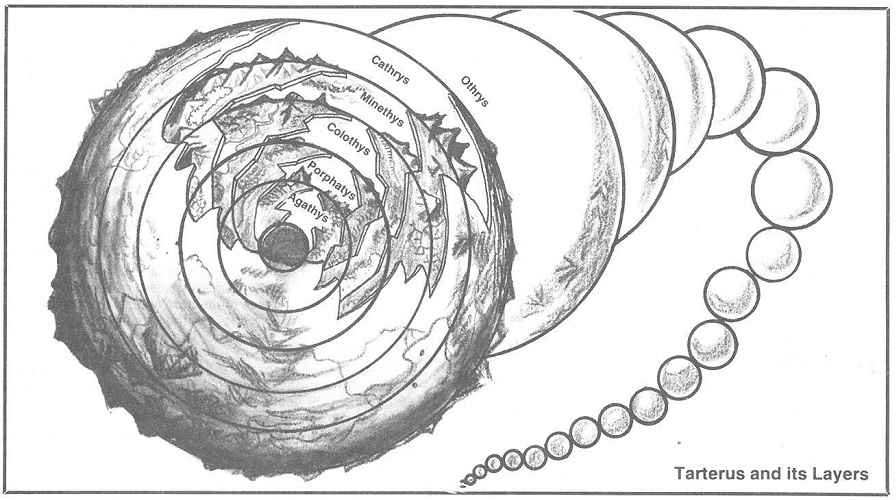
The barriers between
the layers of Tarterus are always located
at the lowest points of a particular orb:
at the bottoms of chasms
|| canyons, or in tunnels beneath the
surface. The barriers on
one orb always lead to the same orb in
the other layer, so the various
layers of this plane can be pictured as
consisting of nested
spheres, one within the next. the barriers
between the fifth &&
sixth layer are underwater. If there are
any layers beyond the
sixth, their barriers are trapped beneath
miles of ice.
The portals of
the upper layer, Othrys, are obselisks, easily identified
and usu. guarded by demons || watch beasts.
The destination of the portal is
determined by the physical dimensions
of
the obelisk. Those that are taller than
they are wide lead to
Hades. Those that are wider than they
are tall lead to the Abyss.
Those whose heights =equal= their widths
lead to Concordant Opposition.
Transfer from plane to plane is made by
touching the
obelisk. No one can say whether these
obelisks were created as
is to control the portals and force
them into non-random fashion,
or if they slowly developed into their
present shapes. In +addition+
to the portals, the river Styx
flows through the topmost layer of
this plane.
Features of
Tarterus is the land
between Hades and the Abyss. It is thus
the contested ground between the main
races of these 2wo
planes, the demons && daemons.
The demons have numbers
on their side, while daemons have some
measure of organization
&& planning. The war between these
2wo forces of evil is little
more than a continual insurgency against
whichever race
becomes top dog in a particular orb. Neither
the great demon
princes nor the daemon lords have seen
fit to interfere. Indeed,
often a powerful arcanadaemon || cambion
has both daemons && demons
in their household (provided it can control
them).
Rising above the continual
struggles of demons && daemons
are the demodands,
a powerful race of winged creatures
that mix the worst features of both demon
&& daemon. They are
the most common of the Tarterian monsters.
In lieu of any other
suitable ruler, a shator (shaggy) demodand
will likely rule part of
an orb. Kelubar && farastu act
as servants to the ruling shator.
They enslave any living being they can
to serve the shator. All
demodands are winged, which enables them
to span the gulfs
between the orbs without difficulty. They
have a sense of direction
in their plane similar to that of the
elementals in their planes.
All but the most powerful demons &&
daemons make way for
these evil creatures in Tarterus.
Also found in Tarterus
are achaierai, nightmares, hordlings,
shadow demons, and mephits. The vargouille
are a common
nuisance. Rumor has it that they were
created by a powerful shator
to plague his foes in other planes, but
they turned on their master
and consumed him. All cretures who make
the layers of Tarterus
their home are immune to the effects of
the plane and all its
layers, including the acid snow and the
cold of the lower layers.
Similar creatures from other planes are
subject to these effects (a
demon lord from the Abyss would be affected
by the cold, unless
protected by other means).
Most of the names of
layers of Tarterus are from the titanish
tongue (the evil titans make their home
in a special loc. on
the first layer). In Othrys, the orbs
of Tarterus are close. On 2wo
particular orbs, a set of
huge peaks, 50 miles high each, erupt
from the marshy plains and link together.
Mount Othrys, which is
also the name of the 2wo orbs and the
layer of the plane itself.
They are ruled by Kronos, once the master
of Olympus, Hades,
and Tarterus, before the coming of the
Greek pantheon and the
downfall of the titanish race. In his
court are Coeus, Crius, and
Oceanus, though these titans also maintain
realms on orbs in the
third, fourth, and fifth layers, respectively.
The orbs of these
titans can normally be reached only from
the twin orbs that
Kronos controls.
The upper layer of Tarterus
was once linked (via Mount Olympus)
to the third layer of Hades, the first
layer of Olympus, and
the various PMPs where the Greek &&
titan pantheons were
worshiped. Mount Olympus met the upper
layer of
Tarterus at Mount Othrys, and it was to
here that the titans
retreated upon their defeat. The Deities
of Olympus used
their combined might to shatter the part
of Mount Olympus that
reached this plane, trapping the titans
in Tarterus.
Kronos and his followers
have waited long to strike back at
either Olympus || Hades, their efforts
hampered by several factors.
The titans outside of Tarterus have become
like the Olympians are
in demeanor. As CG creatures, only the
spirits of
the worst titans descend to Kronos's domain.
Any attack through
the adjacent planes && layers
would raise the ire of their inhabitants.
While Kronos might be able to face off
against the god Hades,
he stands little chance against the combined
forces of Hades.
Hel, Anthraxus, and likely the mobilized
daemons of
Hades and einheriar of Olympus. For this
reason, the titans of
Tarterus wait && plan for the
day they make strike, seizing upon
any travellers who possess abilities,
knowledge, or items that
might {aid} them in retaking Olympus.
Far from the orbs occupied
by the hateful titans, perhaps farther
along that string of orbs or on another
string entirely, the
adjacent orbs of the Finnish Deities Surma
&& Kiputytto exist.
Both are gloomy, marshy places, dark despite
the ever-present
red glow of the plane, and cold from the
first layer of the orbs to
the farthest. Surma's realm is filled
with open graves, and
undead walk freely in his domain. Kiputytto's
realm carries
disease on its winds, so that pthose who
approach do so at the risk of
death by gout, ulcers, or the plague.
Neither receive many
visitors.
Grolantor, god of the
hill giants, is an uncaring power. The
makes his home in the fourth layer of
Tarterus, among the infinite
peaks and mighty chasms. Only rarely does
he venture forth to
check on his worshipers. The orbs in the
layers above the realm
are kept by shator demodands, a weak-willed
toadying lot that
cede to him their vassalage, more from
fear of the evil spirits of
giants that make up the armies of Grolantor
than out of any love
of the hill giant god.
| 1 | 2 | 3 | 4 | 5 | 6 | 7 | 8 | 9 | 10 | 11 | 12 | 13 | 14 | 15 | 16 | 17 | 18 | 19 | 20 | 21 | 22 |
| 23 | 24 | 25 | 26 | 27 | 28 | 29 | 30 | 31 | 32 | 33 | 34 | 35 | 36 | 37 | 38 | 39 | 40 | 41 | 42 | 43 | 44 |
| 45 | 46 | 47 | 48 | 49 | 50 | 51 | 52 | 53 | 54 | 55 | 56 | 57 | 58 | 59 | 60 | 61 | 62 | 63 | 64 | 65 | 66 |
| 67 | 68 | 69 | 70 | 71 | 72 | 73 | 74 | 75 | 76 | 77 | 78 | 79 | 80 | 81 | 82 | 83 | 84 | 85 | 86 | 87 | 88 |
| 89 | 90 | 91 | 92 | 93 | 94 | 95 | 96 | 97 | 98 | 99 | 100 | 101 | 102 | 103 | 104 | 105 | 106 | 107 | 108 | 109 | 110 |
| 111 | 112 | 113 | 114 | 115 | 116 | 117 | 118 | 119 | 120 | 121 | 122 | 123 | 124 | 125 | 126 | 127 | 128 | 129 | 130 | 131 | 132 |
| 133 | 134 | 135 | 136 | 137 | 138 | 139 | 140 | 141 | 142 | 143 | 144 | 145 | 146 | 147 | 148 | 149 | 150 | 151 | 152 | 153 | 154 |
| 155 | 156 | 157 | 158 | 159 | 160 | 161 | 162 | 163 | 164 | 165 | 166 | 167 | 168 | 169 | 170 | 171 | 172 | 173 | 174 | 175 | 176 |
| 177 | 178 | 179 | 180 | 181 | 182 | 183 | 184 | 185 | 186 | 187 | 188 | 189 | 190 | 191 | 192 | 193 | 194 | 195 | 196 | 197 | 198 |
| 199 | 200 | 201 | 202 | 203 | 204 | 205 | 206 | 207 | 208 | 209 | 210 | 211 | 212 | 213 | 214 | 215 | 216 | 217 | 218 | 219 | 220 |
| 221 | 222 | 223 | 224 | 225 | 226 | 227 | 228 | 229 | 230 | 231 | 232 | 233 | 234 | 235 | 236 | 237 | 238 | 239 | 240 | 241 | 242 |
| 243 | 244 | 245 | 246 | 247 | 248 | 249 | 250 | 251 | 252 | 253 | 254 | 255 | 256 | 257 | 258 | 259 | 260 | 261 | 262 | 263 | 264 |
| 265 | 266 | 267 | 268 | 269 | 270 | 271 | 272 | 273 | 274 | 275 | 276 | 277 | 278 | 279 | 280 | 281 | 282 | 283 | 284 | 285 | 286 |
| 287 | 288 | 289 | 290 | 291 | 292 | 293 | 294 | 295 | 296 | 297 | 298 | 299 | 300 | 301 | 302 | 303 | 304 | 305 | 306 | 307 | 308 |
| 309 | 310 | 311 | 312 | 313 | 314 | 315 | 316 | 317 | 318 | 319 | 320 | 321 | 322 | 323 | 324 | 325 | 326 | 327 | 328 | 329 | 330 |
| 331 | 332 | 333 | 334 | 335 | 336 | 337 | 338 | 339 | 340 | 341 | 342 | 343 | 344 | 345 | 346 | 347 | 348 | 349 | 350 | 351 | 352 |
| 353 | 354 | 355 | 356 | 357 | 358 | 359 | 360 | 361 | 362 | 363 | 364 | 365 | 366 | 367 | 368 | 369 | 370 | 371 | 372 | 373 | 374 |
| 1 | 2 | 3 | 4 | 5 | 6 | 7 | 8 | 9 | 10 | 11 |
| 12 | 13 | 14 | 15 | 16 | 17 | 18 | 19 | 20 | 21 | 22 |
| 23 | 24 | 25 | 26 | 27 | 28 | 29 | 30 | 31 | 32 | 33 |
| 34 | 35 | 36 | 37 | 38 | 39 | 40 | 41 | 42 | 43 | 44 |
| 45 | 46 | 47 | 48 | 49 | 50 | 51 | 52 | 53 | 54 | 55 |
| 56 | 57 | 58 | 59 | 60 | 61 | 62 | 63 | 64 | 65 | 66 |
| 67 | 68 | 69 | 70 | 71 | 72 | 73 | 74 | 75 | 76 | 77 |
| 78 | 79 | 80 | 81 | 82 | 83 | 84 | 85 | 86 | 87 | 88 |
1.
2.
3.
4.
5.
6.
7.
8.
9.
10.
11.
12.
13.
14.
15.
16.
17.
18.
19.
20.
21.
22.
23.
24.
25.
26.
27.
28.
29.
30.
31.
32.
33.
34.
35.
36.
37.
38.
39.
40.
41.
42.
43.
44.
45.
46.
47.
48.
49.
50.
51
52.
53
54.
55.
56.
57.
58.
59.
60.
61.
62.
63.
64.
65.
66.
67.
68.
69.
70.
71.
72.
73.
74.
75.
76.
77.
78.
79.
80.
81.
82.
83
84.
85.
86.
87.
88.
clore wrote:
Quote:
Your experience is certainly
with bad editors.
I have had both sorts.
But never one good enough
to catch egregious misspellings of common words like "dero", "dinichthys",
"doppelganger", "erinnyes", "lemur", "tarasque", and "Tartarus"? ![]()

Frankly, sir...
You are a bore.
Did it ever occur to you that some words are not as others have spelled them so as to make the attached monster information unique?
That aside, I was speaking
primarily of fiction editors.
Have you ever written any
fiction that was published?
Gary
*template***template*